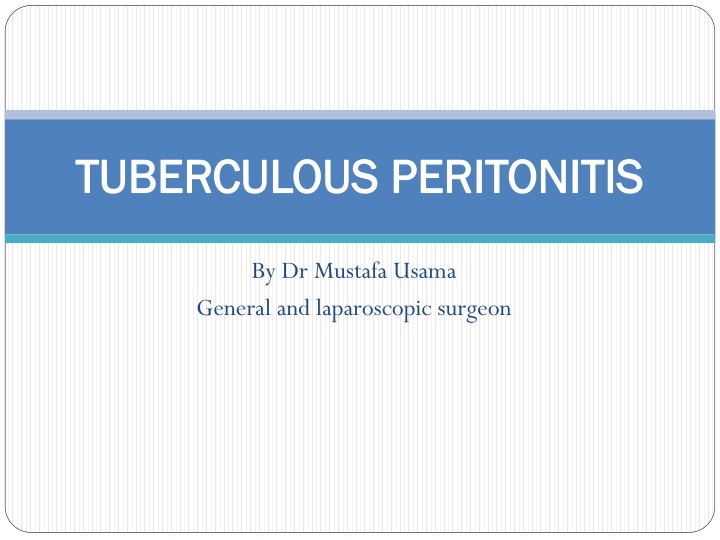
Tuberculous Peritonitis: Causes, Symptoms & Varieties
Tuberculous peritonitis is a rare form of tuberculosis affecting the peritoneum. Learn about its origins, acute and chronic presentations, varieties like ascitic, encysted, and fibrous forms, along with common symptoms such as abdominal pain, fever, and ascites.
Download Presentation

Please find below an Image/Link to download the presentation.
The content on the website is provided AS IS for your information and personal use only. It may not be sold, licensed, or shared on other websites without obtaining consent from the author. If you encounter any issues during the download, it is possible that the publisher has removed the file from their server.
You are allowed to download the files provided on this website for personal or commercial use, subject to the condition that they are used lawfully. All files are the property of their respective owners.
The content on the website is provided AS IS for your information and personal use only. It may not be sold, licensed, or shared on other websites without obtaining consent from the author.
E N D
Presentation Transcript
TUBERCULOUS PERITONITIS TUBERCULOUS PERITONITIS By Dr Mustafa Usama General and laparoscopic surgeon
Origin of the infection Origin of the infection Infection originates from: tuberculous mesenteric lymph nodes; tuberculosis of the ileocaecal region; a tuberculous pyosalpinx; blood-borne infection from pulmonary tuberculosis, usually the miliary but occasionally the cavitating form.
Acute Acute tuberculous tuberculous peritonitis peritonitis Tuberculous peritonitis sometimes has an onset that so closely resembles acute peritonitis that the abdomen is opened. Straw coloured fluid escapes and tubercles are seen scattered over the peritoneum and greater omentum. Early tubercles are greyish and translucent. They soon undergo caseation and appear white or yellow and are then less difficult to distinguish from carcinoma.
Chronic Chronic tuberculous tuberculous peritonitis peritonitis The condition presents with abdominal pain (90% of cases), fever, loss of weight ,ascites (60%), night sweats and abdominal mass (26%)
Varieties of Varieties of tuberculous tuberculous peritonitis peritonitis 1-Ascitic form The peritoneum is studded with tubercles and the peritoneal cavity becomes filled with pale, straw-coloured fluid. The onset is insidious. There is loss of energy, facial pallor and some loss of weight. The patient is usually brought for advice because of distension of the abdomen.
2-Encysted form The encysted (loculated) form is similar to the ascitic form except that one part of the abdominal cavity alone is involved. Thus, a localised intra-abdominal swelling is produced.
3-Fibrous form The fibrous (synonym: plastic) form is characterised by the production of widespread adhesions, which cause coils of intestine, especially the ileum, to become matted together and distended
4-Purulent form The purulent form is rare. When it occurs, usually it is secondary to tuberculous salpingitis. Amidst a mass of adherent intestine and omentum, tuberculous pus is present. Sizeable cold abscesses often form and point on the surface,















